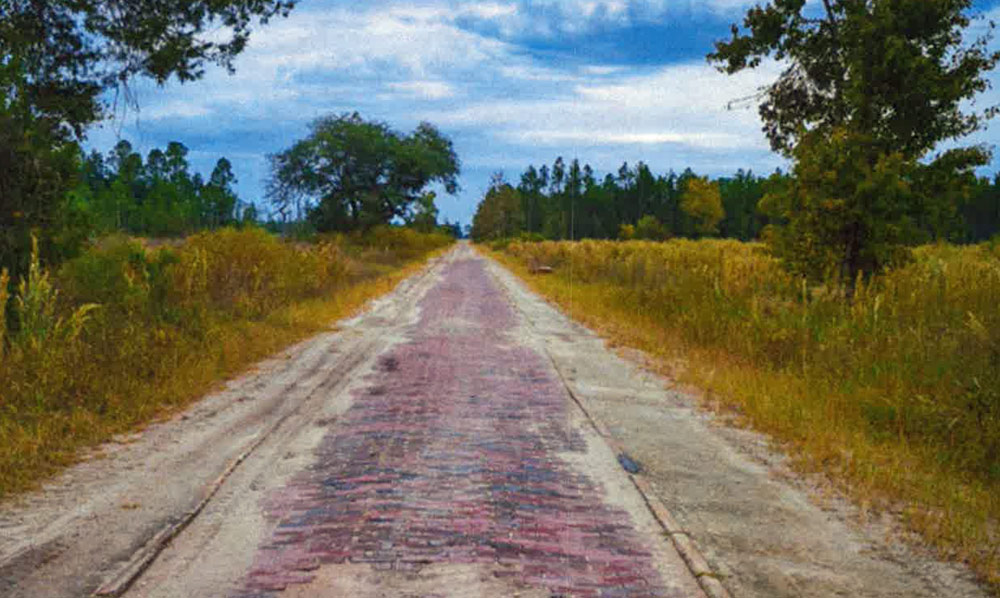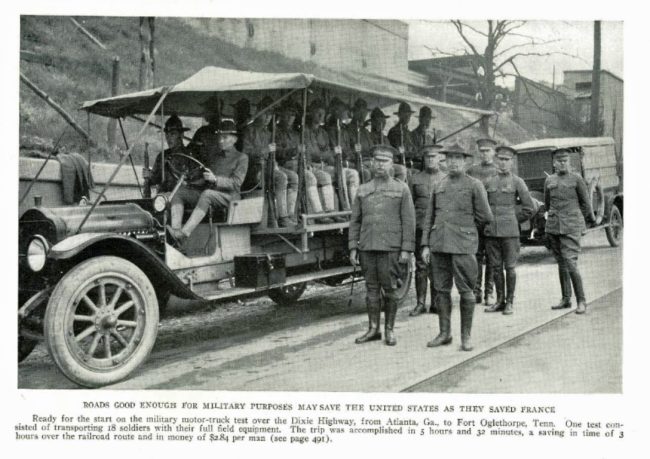
Old Brick Road used to be part of the less politic Dixie Highway–the Dixie Highway that stretched from Detroit to Miami. Old Brick Road stretched eight miles starting in Espanola in Flagler County, north to St. Johns, where it continues for two miles. The pavement is made of stately old red, now darkly rusted, bricks. is “the longest such road in the state of Florida today,” County Attorney Sean Moylan says. Its dark-red ribbon cuts a path through the scrub of undeveloped west Palm Coast, the area slated for the city’s so-called “westward expansion.
If Old Brick Road were an animal, it would be endangered. As it is, Old Brick Road is at risk of decomposition or destruction if it is not managed and secured. Flagler County government is trying to do just that, even though Palm Coast annexed the land. There are no protections for Old Brick Road in the city’s comprehensive plan. The road remains in the county’s ownership: the county has been maintaining it for seven years. But that doesn’t pre-empt certain city rights.
“They have their comp plan in place, their land development regs,” Moylan said, of city regulations, “but we still control the right of way, just like for instance, Colbert Lane is in the city of Palm Coast. It’s a county road within the city limits. This is now the same situation.”
The loop road or beltway that cuts west from Palm Coast Parkway to Matanzas Woods Parkway, a road for which Palm Coast secured nearly $100 million in state appropriations, will cross Old Brick Road in two places. No one yet knows how, or what effect that’ll have on the road. But the city is unlikely to spend the significant additional sums required to fly over or dig under the road. It is likelier to cross it, and asphalt it in that crossing.
On Monday, Moylan presented a brief history of the road to the County Commission, along with a recommendation to bring the road “to the forefront again.” The road ahead may be bumpier than the bricks underfoot: as Commissioner Greg Hansen noted, developers could build right up to the narrow road. And an entire Development of Regional Impact is named for Old Brik Road. Old Brick Township, as it is called, may accelerate the road’s demise: it is slated for some 5,000 houses and 1.15 million square feet of commercial and industrial development. A silver lining: the developer, recognizing the historic value of the road, doesn’t want it paved.
The road appears on the very first plat map of Flagler County. It is listed on the National Register of Historic Places and is part of Florida’s Heritage Crossroads, which crisscross in Flagler, Volusia and St. Johns counties. When Flagler became a county in 1917, completing the roadway–with convicts–was one of the new County Commission’s first actions. It became a state road until the 1960s, when it reverted back to the county.
The original Dixie Highway went from Michigan to Miami. Its segment from Atlanta to Fort Oglethorpe, Tenn., was featured in a 1917 National Geographic picture over the caption: “ROADS GOOD ENOUGH FOR MILITARY PURPOSES MAY SAVE THE UNITED STATES AS THEY SAVED FRANCE.”

“So it has a lot of distinctions,” Moylan said, “but we also want to make sure that we protect it, because it is now under development pressure. Palm Coast has annexed the silviculture area going all the way up to and past the old brick road, and one day in the future, that area will be developed.”
The county bought a well in the area in 2003, when the road was placed on the National Register and a county consultant created a management plan for the road.
“The number one thing that consultant recommended was that we get the logging trucks off the road,” Moylan said. That hasn’t happened, even though the road was designed for Model T’s, not multi-ton trucks. Rayonier, the Jacksonville-based logging company, owns the vast majority of the land out there. “Starting around the 90s, as far as anyone knows, we started dumping topsoil and sand onto the bricks to protect them from the logging trucks. And that has continued to this day. Every so often, our crews go out there to reapply it as it is pushed off onto the shoulders, but eventually at some point, we will need to get those trucks off the road.”
County Administrator Heidi Petito met with Palm Coast officials and a Rayonier representative, who told them halting truck traffic on the road would very disruptive. “So it wouldn’t be fair to just all at once say, Hey, get off the road. But I think at some point we need to have a plan to make it happen,” Moylan said.
“When we met with them,” Petito said, “the developer and the city are in agreement with us. They don’t want to pave it, they want to continue to celebrate it in the future. They would like to see it be preserved as a linear trail. They conceptualize having some sort of a city park in close proximity to it, and potentially using it as maybe historic festivals or events, where maybe you would at a future time, maybe have Model T’s back on there as part of a celebration.”
The management plan recommends using bricks from portions of the road that are being asphalted to repair other portions that have been damaged. Beyond that is development, with needed crossings over the road to accommodate future residents in the area. What that’ll look like is unknown, but it’ll be in the context of a linear-park-like facility with biking and hiking.
“The management plan mentioned things like kiosks and signs and interpretive kiosks to help people understand the history,” Moylan said. “It recommended using some of the original type of signage that was on the Dixie Highway when it was first built.” The road would remain a cultural resource.
The county could enact restrictive covenants, though that may not be necessary: it’s not as if it can be paved over without the county’s permission (which will not be given). But it can’t stop development on either side of it. Fencing is not recommended: “It might be better to engage the landowner and the city and try to maybe come up with a number of crossings, as opposed to the exact location, and to say okay, what can we cap it at? Because we know there’s going to be some number of crossings. Whether a person walks onto the old brick road is fine. They can walk it all they want and hike it. But what we’re concerned about is if there’s too many crossings, roadway asphalt crossings, you chop it up too much, and it loses its character.”
Moylan is recommending developing a more concrete plan with Palm Coast to take the measure of the problem, or opportunities, to protect the road. “How do we make sure this road is preserved for future generations,” he said: that’s the goal.
“At some point out there, you’re not going to be able to use this road anymore. It’s going to be a walkway or bicycle way,” Commissioner Greg Hansen said.
County Commission Chair Andy Dance said protections could be built in through development plans such as planned unit developments. The county won’t be able to direct such codifications, but could ensure them in cooperation with the developer. “We don’t approve the PUD, we will only have the ability to influence it,” Dance said. Fellow-Commissioner Leann Pennington wants a more concerted effort to protect the road “today,” she said, whether through a joint agreement with Palm Coast or through the drafting of covenants for Old Brick Road.
What that will look like is not yet clear.
![]()






























Doug says
Well ain’t that shocking, because every square foot of dirt everywhere else is being dug up and replaced with developments. At least the county will have some history to reflect back onto.
Billy B says
Just another white elephant for Palm Coast to piss away millions on !!!
Atwp says
Spending money to maintain a road that is probably not used. The priorities of this county. Get ready for a county tax increase.
Billy says
Developers are destroying our history, woodlands, wildlife,etc. who in the hell wants to live in 250,000 sardine can side by side cookie cutter homes and sweat like hogs in the summer!
JimboXYZ says
Alfinville & the “Vision of 2050” strikes again. As they build around it, maybe it needs to become a bike trail ? 9 continuous miles is a pleasant bicycle ride.
JimboXYZ says
Here’s an idea, Rayonier & the State & Local Governments could dismantle the brick road & auction off those miles of historic brick to pay for their “Vision of 2050” ? Imagine each brick being worth +/- $ million or more for a piece of American history ?
Greg Feldman says
From what I have observed and been told about from those who have been here far longer than I have, Palm Coast development projects have all but obliterated any historical remnants of what this county used to be east of US 1. This beautiful road must be preserved at all costs. Work with landowners such as Rayonier, and developers, to carve out an alternate road to carry logs between CR 204 in St. Johns and Espanola. A connection to the Palm Coast Industrial Park by Matanzas and US 1 would probably make sense, be shorter, and be a better road to navigate. That road will be necessary, as it is, for future development already planned and expected. Let that be a proactive approach to historic preservation.
As a roadway listed on the National Register of Historic Places as well as a designated Florida Heritage Crossroad, it is encouraging that the developer recognizes the importance and doesn’t want to pave it. Since the developments that far out west aren’t happening tomorrow, the city and the county have time to act and seek out appropriations to preserve Old Brick Road and work with the cooperative developer to ensure their success as well as Flagler County’s.
Model T says
I feel that the County has done a fairly decent job of persevering our historic and natural resources. The old brick road is a true historic gem and it’s great to see discussion and planning for its preservation. However, all options need to be discussed here, not just one consultant’s management plan. The remote location of the road will be a negative and it may not get much use. Trailheads with parking areas will need to be created for one. These street bricks are not conducive to foot traffic and may actually pose a liability to users. The idea of a parallel bike path and equestrian trail are good, but the area lacks any tree canopy for shade. The thought of this wonderful piece of history meandering through a residential subdivision is a complete turn off, especially when the trail leads to nowhere. Then the thought of maintaining 8 miles of this trail plays into it, who pays? Maybe consider leaving only sections of the old brick and paving the rest for bike and foot traffic. Also, relocating some brick sections to create a replica old brick road in Bunnell near the Holden House or/and the Agricultural Museum. These settings would get more appreciation and exposure in recognition of its historic value.
Nephew Of Uncle Sam says
The Route was originally conceived in Chattanooga as a Chicago to Miami route, Michigan was later added starting up in Sault St. Marie to Miami. One was called the Western Route and the other was called the Eastern Route.
It would be a shame if another part of United States history were to be plowed under by Palm Coast just for developers.
Marie says
Of course they will destroy it, and spend lots of tax dollars doing it. It’s all about spend spend spend and raise those taxes. Then when the developments are in and developers are gone, and salt water intrusion to our water supply happens, who will be here to pay for that costly upgrade to infrastructure.
Better buy sink hole insurance too. That will be our next problem.
Walt says
I made the mistake of retiring here three years ago. Way too overpopulated too much crime for me. We recently just sold our house , lost $25,000. Then I immediately moved back to the great blue ridge mountains in North Carolina. A small, peaceful town so much happier!
Mischa Gee says
This Historic road should be preserved I. It’s entirety. If Pal Coast doesn’t know how to get developers to cover costs of passovers, then they shouldn’t develop the land on the other side of this road.
A walking and bike path that parallels the old brick road could be developed and a seven mile linear park as well. Put in some parking areas. Plant some trees close, but not so close as to have their roots undermine it, picnic benches in the shade. Do it in a cost effective way, and draw hikers, who will utilize restaurants and hotels while visiting.
Encourage a donation to cover maintenance now and in the future.
Gene Andrews says
My family moved to Palm Coast in 2006 from Brick Township N.J.. Because of the population explosion in Brick Township N.J. it’s name changed to called Brick New Jersey.
Mike Miller says
Milton in the Florida Panhandle has done a good job of preserving part of their brick road. The Red Brick Road in Milton, Florida, is a historic remnant of early 20th-century infrastructure, originally part of the Old Spanish Trail, also known as State Road 1. Constructed between 1919 and 1921, this brick-paved road stretched from Milton eastward toward the Santa Rosa County line. Initially, it spanned just 6 miles and was a narrow 9 feet wide, designed to accommodate the growing use of automobiles in the region. In 1926, concrete shoulders were added to widen it into a two-lane road, improving its functionality. By 1929, it was designated as part of U.S. Highway 90, a major coast-to-coast route. However, its significance as a primary roadway diminished in 1955 when a new, parallel section of Highway 90 was built, relegating the brick road to local use.
The road’s bricks likely came from regional manufacturers like the Southern Clay Manufacturing Company, which supplied paving bricks for early roads across Florida and the South, reflecting the era’s reliance on durable, locally sourced materials. Today, it stands as one of the few surviving brick roads in Florida still in partial use, offering a tangible link to the state’s early automotive history.
Preservation efforts by the city of Milton and Santa Rosa County have ensured that a section of this road remains intact. While much of the original 6-mile stretch has been bypassed or lost to time, a short, drivable portion—roughly a few hundred yards—remains accessible off Highway 90, just east of the Blackwater River. This segment, often referred to as the “Old Red Brick Road,” was recognized for its historical value and registered as a National Historic Site in 1994, thanks to advocacy from Santa Rosa County visionaries. The county’s efforts focused on maintaining this westernmost stretch for public use, allowing visitors to drive or walk on it and experience a piece of 1920s Florida.
Beyond this drivable section, the road extends approximately 5 miles eastward, running parallel to modern Highway 90. Though this longer portion is not open to vehicular traffic, it has been preserved as a historic trail, popular for hiking and exploration. Preservation was partly a grassroots effort, with local interest in retaining the road’s character as a symbol of Milton’s past, tied to its timber and shipping heritage along the Blackwater River. In the 1970s, before its official historic designation, Governor Reubin Askew permitted the removal of some bricks for a sidewalk project in Pensacola, but the core Milton section was spared and later protected. Today, Milton’s Historic Preservation Program, which oversees the city’s broader historic district (listed on the National Register in 1987), indirectly supports the road’s legacy by fostering a culture of heritage conservation, though specific maintenance of the brick road falls more to county jurisdiction.
The preserved section’s survival reflects a blend of practical reuse—still serving a 1940s East Milton neighborhood—and deliberate historical appreciation, balancing function with nostalgia in a region increasingly shaped by modern development.